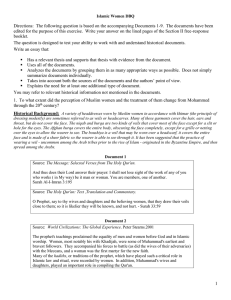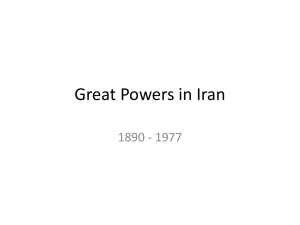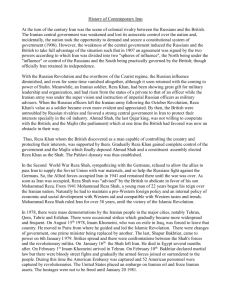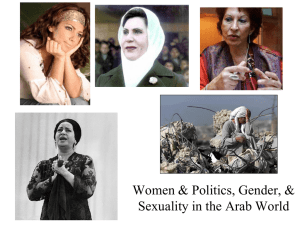World History DBQ#1: Islamic Women
advertisement
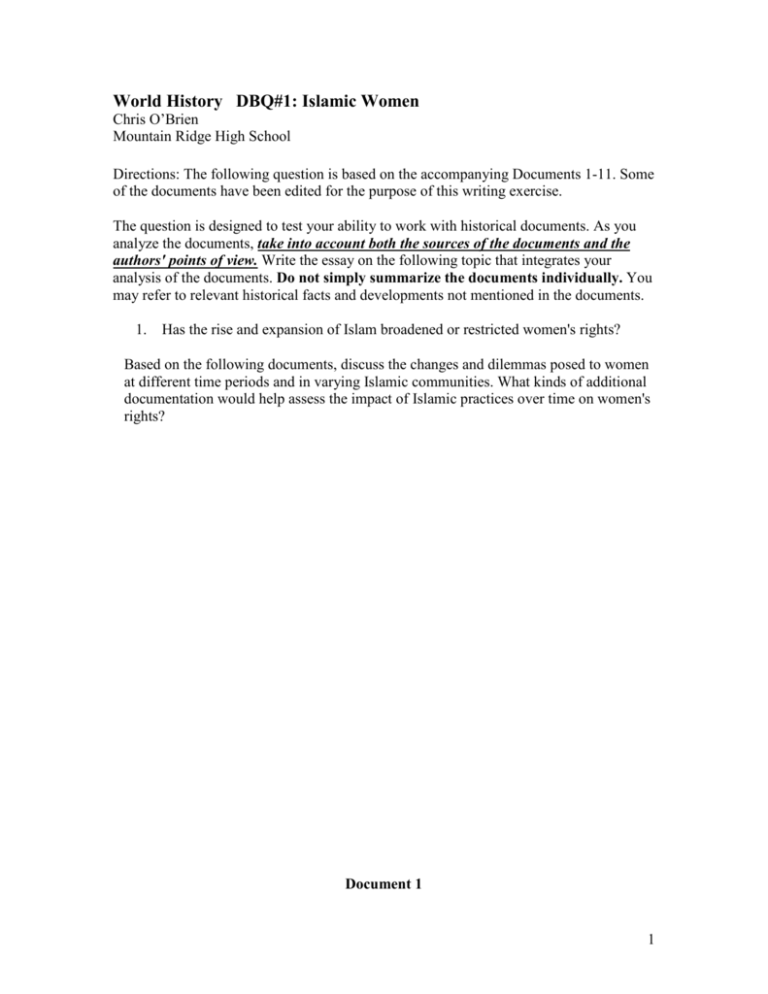
World History DBQ#1: Islamic Women Chris O’Brien Mountain Ridge High School Directions: The following question is based on the accompanying Documents 1-11. Some of the documents have been edited for the purpose of this writing exercise. The question is designed to test your ability to work with historical documents. As you analyze the documents, take into account both the sources of the documents and the authors' points of view. Write the essay on the following topic that integrates your analysis of the documents. Do not simply summarize the documents individually. You may refer to relevant historical facts and developments not mentioned in the documents. 1. Has the rise and expansion of Islam broadened or restricted women's rights? Based on the following documents, discuss the changes and dilemmas posed to women at different time periods and in varying Islamic communities. What kinds of additional documentation would help assess the impact of Islamic practices over time on women's rights? Document 1 1 Source: The Message: Selected Verses from The Holy Qur'an. Mohammed Keramat Ali. 1993. And thus does their Lord answer their prayer: I shall not lose sight of the work of any of you who works ( in My way) be it man or woman. You are members, one of another. Surah Al-I-Imran 3:195 Source: The Holy Qur'an: Text ,Translation and Commentary. Abdullah Yusuf Ali. 1989. O Prophet, say to thy wives and daughters and the believing women, that they draw their veils close to them; so it is likelier they will be known, and not hurt. - Surah 33:59 Document 2 Source: World Civilizations: The Global Experience. Peter Stearns.2001 The prophet's teachings proclaimed the equality of men and women before God and in Islamic worship. Women, most notably his wife Khadijah, were some of Muhammad's earliest and bravest followers. They accompanied his forces to battle (as did the wives of their adversaries) with the Meccans, and a woman was the first martyr for the new faith. Many of the hadiths, or traditions of the prophet, which have played such a critical role in Islamic law and ritual, were recorded by women. In addition, Muhammad's wives and daughters, played an important role in compiling the Qur'an. Document 3 2 Source: The Human Record: Sources of Global History. Vo. I. Andrea Overfield.2001 Men are appointed guardians over women, because of that in respect of which Allah has made some of them excel others, and because the men spend their wealth. So virtuous women are obedient and safeguard, with Allah's help, matters the knowledge of which is shared by them with their husbands. Surah: 4:35 Ibn Umar relates that the Honorable Prophet said: Every one of you is a steward and is accountable for that which is committed to his charge. The ruler is a steward and is accountable for his charge, a man is a steward in respect of his household, a woman is a steward in respect of her husband's house and his children. Thus everyone of you is a steward and is accountable for that which is committed to his charge. ( Bohkari and Muslim) Abu Ali Talq ibn Ali relates that the Honorable Prophet said: When a man calls his wife for his need, she should go to him even if she is occupied in baking bread. (Tirmidhi and Nisai)… Umm Salamah relates that the Honorable Prophet said: If a woman dies and her husband is pleased with her, she will enter Paradise. (Tirmidishi) Document 4 3 Source: The Earth and Its Peoples: A Global History. Richard Bulliet. 1997 Slave Girls from Samarra. This early 9th century wall painting is from the harem quarters of the Abbasid palace in Samarra. Unveiled slave girls commonly sang, danced, and played instruments at parties. Islamic law prohibited wine but wine songs feature prominently in Arabic poetry in this period. (Bildarchiv Preussischer Kulturbesitz). Document 5 4 Source: The Human Record: Sources of Global History,V.II,2001. Andrea Overfield Women in Ottoman Society. Ogier Ghiselin de Busbecq,TURKISH LETTERS To Ogier de Busbecq (1522-1590), the European diplomat who resided in sixteenth-century Istanbul for six years, the role of women was one of many extraordinary aspects of Ottoman culture. The Turks are the most careful people in the world of the modesty of their wives, and therefore keep them shut up at home and hide them away, so that they scarce see the light of day. But if they have to go into the streets, they are sent out so covered and wrapped up in veils that they seem to those who meet them mere gliding ghosts. They have the means of seeing men through their linen or silken veils, while no part of their own body is exposed to men's view. For it is a received opinion among them, that no woman who is distinguished in the very smallest degree by her figure or youth can be seen by a man without his desiring her, and therefore without her receiving some contamination; and so it is the universal practice to confine the women to the harem. Their brothers are allowed to see them, but not their brothers-in-law. Men of the richer classes, or of higher rank, make it a condition when they marry, that their wives shall never set foot outside the threshold, and that no man or woman shall be admitted to see them for any reason whatever, not even their nearest relations except their fathers and mothers, who are allowed to pay a visit to their daughters at the Turkish Easter.[ A reference to the festival of Bairam, which follows Ramadan]. … The Turks are not forbidden by any law to have as many concubines as they please in addition to their lawful wives. Between the children of wives and those of concubines there is no distinction, and they are considered to have equal rights. … Concubines are entitled to their freedom if they have borne children to their master. … A wife who has a portion settled on her [brought dowry to the marriage], is the mistress of her husband's house, and all other women have to obey her orders. The husband, however, may choose which of them shall spend the night with him. He makes known his wishes to the wife and she sends to him the slave he has selected. Only Friday night, which is their Sabbath, is supposed to belong to the wife… On all the other nights he may do as he pleases. Divorces are granted among them for many reasons easy for the husbands to invent. The divorced wife receives back her dowry, unless the divorce has been caused by some fault on her part. There is more difficulty in a woman's getting a divorce from her husband. Document 6 5 Source: Women in Islam. Marjorie Wall Bingham and Susan Hill Gross.1980 EGYPT: In 1899, Qasim Amin published a book called The Emancipation of Women. In the book he called for such mild reforms as: 1) some basic education for women 2) somewhat more physical freedom though not outlawing the veil 3) changes in the divorce laws to make them fairer to women Though these suggestions no longer seem radical, his book caused violent opposition in Egypt. Articles, books and pamphlets were written against his idea. He, however, continued his campaign for the liberation of Egyptian women. … He is credited with starting the Egyptian movement for rights of women. EGYPT 1952: A religious ruling denied women the right to vote because they were too "swayed by emotions and, therefore, of incompetent and unstable nature." For ten more years the "Daughters of the Nile" and other groups fought to get women the vote. EGYPT 1962: Women received the right to vote. The first woman minister was appointed. In the charter of 1962 (after the Revolution of 1958 brought Nasser to power) was the following declaration: Women must be regarded as equal to man and she must therefore shed the remaining shackles that impede her free movements, so that she may play a constructive and profoundly important part in shaping the life of the country. 6 Document 7 Source: Women in the Middle East: Tradition and Change. Ramsay M. Harik.1996 A popular Islamic leader and television personality in Cairo explains the resurgence of veiling during the mid 20th century in this way: the sight of a woman's beauty- especially her hair- is so alluring that it can be intolerably distracting to men. It turns their thoughts away from pious, proper behavior: an adolescent youth suffers from frustrated sexual desire, and a middle aged man thinks of discarding his wife and finding a much younger woman. To prevent men from experiencing this agitation, which makes them uncomfortable and can even lead to social disorder, it is the duty of all women, regardless of age or condition, to conceal their hair and shape of their bodies. Women must behave in such a way as to remove temptation from men's paths. In this respect, women are held responsible for men's emotions and conduct. A woman's freedom to leave her home and do what she needs or wants to may thus, in a given situation, depend on her wearing the veil (hijab). Assertion of her religious and cultural identity, in a time of fast-changing values and practices, may impel her to put on the veil. The social setting in which she lives may require the veil. But the ultimate meaning of "covering" still raises disturbing questions. Document 8 7 Source: The Iranians: Persia, Islam, and the Soul of a Nation. Sandra Mackey. 1997 Note: Reza Sha Pahlevi ruled from 1921 to his abdication in September 1941. Of Reza Shah's moves against the institutions and practices of Shiism, none elicited the same level of public response as did changes in the status of women. In an act pregnant with symbolism, Reza Shah put women on the front line of his social revolution against Islam. His motives rested in nationalism rather than in an engagement with the questions of religions and patriarchy. Illiteracy among women denied skills needed for nation building. Child brides and the practice of muta, or temporary marriage brushed Iran with the stain of backwardness. Finally, the chador of funereal black that enveloped women spoke not only of the subordination of females but the subordination of Iran. By tearing away the veil, an emblem of religious traditionalism, Reza Shah announced his intentions to enlist women in the resurrection of Iran. But the unveiling of women enraged the religious establishment. The confrontation between Reza Shah and the clergy over the veil began almost by accident. In March 1928, the Shah's wife came to Qom to pray at the shrine of Fatima. While in an upper gallery, changing from a heavy chador designed for the street to a lighter one for prayer, she momentarily exposed her face. A mullah happened to see her. With a chorus of students behind him, he poured shame upon her. The next day, Reza Shah pulled up in front of the gold-domed shrine accompanied by two armored cars and four hundred troops. He strolled through the gate in his heavy military boots and across the graves of Shiism's holy men. Finding the offending mullah, he knocked off his Turban, grabbed him by the hair, and thrashed him with a riding crop. Then he turned and left, leaving Qom and Iranian Shiism stunned. … Throughout 1928, hints surfaced that the chador would be banished to the trash heap of the past. Although angry demonstrations did nothing to deter Reza Shah from his chosen path, he proceeded with caution. Women's groups composed of educated, middle-and upper-class women organized to beat the drum of support. In 1934, government policy first allowed, and then ordered, women teachers and female students to appear in school without the chador. At the same time, cinemas, restaurants, and hotels, on pain of heavy fines, unlocked their doors to both sexes. Finally, a 1935 government decree banned the veil entirely. Document 9 8 Source: Women in Islam. Marjorie Wall Bingham.1980. In 1979 Iran was shaken by social and political upheavals. The Shah of Iran was overthrown and replaced by an Islamic Republic. The Ayatollah Khomeini, a prominent religious figure, led the formation of a new Islamic government after the fall of the Shah. Document 10 9 Source: Faces in a Mirror: Memoirs from Exile. Princess Ashraf Pahlavi.1980. In this memoir, the twin sister of Shah Mohammed Reza Pahlavi [1941-1979], tells the extraordinary story of her life and of her country. She narrates her own fiercely determined rise to independence and the political activities of her family. The book offers inside information - as only she could know them- on the events that surrounded the removal of her brother, the Shah, the take-over by the Khomeini regime and the international furor that resulted from her brother's treatment at a New York City Hospital. Seeing my brother again, [1933] seeing what life was like in Switzerland, made me desperately want to stay. I knew that it would be difficult to get my father's permission, and I was too afraid to ask when he telephoned Le Rosey from Turkey. (He had gone to see the man who had inspired so many of his plans for Iran, Mustafa Kemal, and he took advantage of the international phone system, which we didn't have in Iran.) I sent a telegram, asking if I might remain and study in a European school. His answer was a short, harsh cable: " Stop this nonsense and come home at once." There was no explanation; but this too was typical of Reza Shah. I was furious and disappointed and hurt when I realized that no matter how much education my father might allow at home, I would always be denied the opportunities he gave my brothers. Disappointed and angry though I was, I didn't dream of disobeying. In the Middle Eastern world, fathers were obeyed even if they weren't kings. My father's answer closed the door forever on a dream that had become for a little while more real and more compelling than the life that was chartered for me. For a brief, tantalizing moment I had seen the reality of a world where a woman could develop her capabilities, could shape and form her own life. In Europe I had seen it, touched it, experienced it, but now the moment was over for me. I vowed that in the years to come I would find a way to make contact with Europe and the Western world. 10 Document 11 Source: The Washington Post. Friday, 10-19-2001 " 'Small Steps' for Afghan Women's Rights." Lois Raimondo KHODJA BAJAHUDDIN, AfghanistanThe silent shapes slide quickly and efficiently down the street, clothed from head to toe in bulky garment called burqas. They do not talk to strangers. They rarely stop to talk to other women. If approached, they turn their veiled faces and walk the other way From a distance, the bright white, pastel blue and green burqas seemed to flutter lightly across an otherwise hard and dusty landscape. Up close, the heft of the heavy folds of fabric becomes noticeable when a husband beats his wife with a stick for standing still as a foreigner comes near. 11
